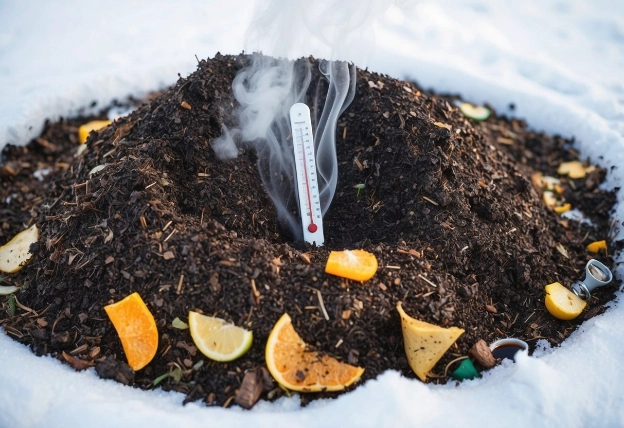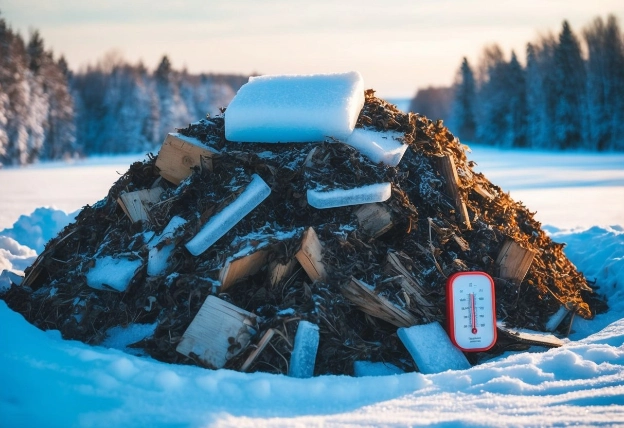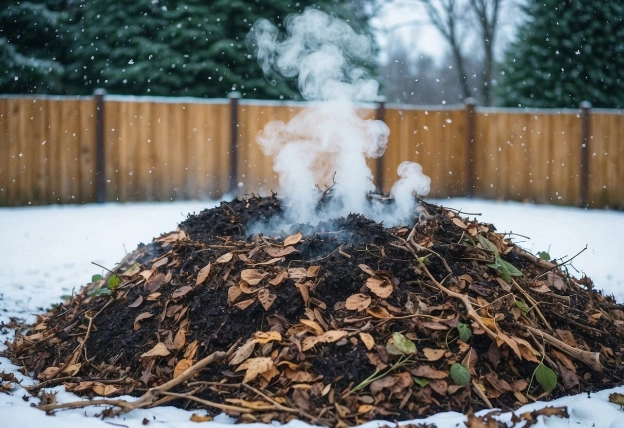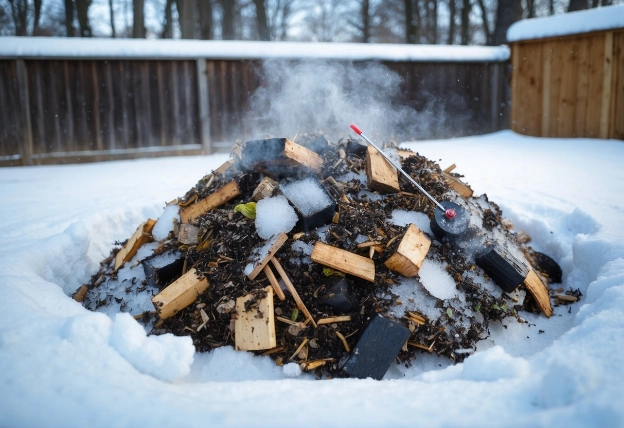Troubleshooting Winter Composting: Easy Solutions for Common Problems

Troubleshooting Winter Composting:
Winter can be a challenging time for composting, but it doesn’t have to be. Many of us worry that our compost piles might freeze or stop breaking down in cold weather.
By understanding how to maintain temperature and balance moisture, we can keep our compost active all winter long.
Throughout this post, we will explore common problems we face during winter composting. From managing temperature drops to ensuring the right mix of materials, we will cover practical solutions to help us achieve healthy compost even in the cold months.
Let’s dive into the tips and tricks that can make our winter composting successful.
Key Takeaways
Proper temperature management is key for winter composting.
Balancing moisture ensures effective decomposition.
The right compost materials can optimize the breakdown process.
Understanding the Basics of Composting in Winter
Composting in winter can be a bit different than during warmer months. Specific factors affect how we compost as temperatures drop. Let’s look at the science behind composting and the unique challenges we face in colder weather.
The Science of Composting
Composting is a natural process that breaks down organic materials, improving soil health. It uses heat and microbes to decompose kitchen scraps and yard waste. In winter, the cold slows down microbial activity, which can slow composting.
To keep things composting, we can manage a few key elements:
Insulation: Use materials like straw or leaves to insulate the compost pile or bin. This helps trap warmth.
Moisture: Keep the compost slightly moist—too dry or too wet can hinder the process.
Aeration: Turn the pile regularly to provide oxygen. This encourages active microbes, even in the cold.
Challenges Unique to Winter Composting
Winter brings some challenges that we don’t face in warmer months. One major issue is the temperature drop. If it’s too cold, our compost may freeze, which stops the decomposition process.
We also need to consider:
Limited Ingredients: Fewer fresh materials are available in winter. We may need to collect more kitchen scraps to keep our pile active.
Water Content: Cold weather can dry out our compost or make it too wet from melting snow. Monitoring moisture is crucial.
Condensation: Moisture can form ice in our compost pile. It’s important to check and break up any ice that forms to keep the process flowing.
We can maintain a healthy compost system by addressing these challenges, even in the winter months.
Maintaining Adequate Temperature
Keeping our compost pile warm during winter is crucial for the breakdown of materials. We can use various methods to retain heat and ensure our compost remains active even in the cold.
Insulation Techniques
Insulation helps keep heat from escaping our compost pile. We can use straw bales, wood chips, or even old blankets.
Straw Bales: Surrounding the pile with straw bales creates a barrier against the cold.
Wood Chips: These can cover the top to trap heat inside.
Blankets: Placing old blankets or tarps over the pile holds warmth.
By using these materials, we create a warm and cozy environment for microorganisms to thrive. We also want to ensure our compost is not too compacted, as air is necessary for composting.
Active Heating Strategies
We can implement active heating methods to boost temperature when it’s particularly cold.
Heating Cables: Installing heating cables or mats in the compost can help raise the temperature.
Hot Water Bottles: Using bottles filled with hot water and burying them in the pile can provide extra warmth.
It's important to monitor the temperature regularly. We can use a compost thermometer for this purpose.
Using these strategies, we can keep our compost warm and effective throughout winter.
Balancing Moisture and Dryness
Finding the right moisture level in compost during winter can be tricky. Too much water can lead to anaerobic problems, while too little can slow down the breakdown of materials. Let’s look at how to monitor moisture levels, handle excess moisture, and deal with dry compost.
Monitoring Moisture Levels
We should regularly check the moisture in our compost pile. A good way to do this is to grab a handful of compost and squeeze it. If a few drops of water come out, it's just right.
Aim for a moisture level of about 40-60% for best results.
Using a moisture meter can help us measure more accurately. Keeping a close eye on moisture lets us know when to add water or more dry materials.
Addressing Excess Moisture
If we notice our pile is too wet, we must act quickly. One way to manage excess moisture is to add dry materials like straw, shredded leaves, or cardboard. These help absorb the extra water.
Turning the compost more often allows air to circulate, speeding up drying. If the pile stays soggy, we might need to cover it to protect it from snow or rain. Adding materials with high carbon content helps balance moisture.
Dealing with Dry Compost
On the flip side, if we find our compost too dry, we can fix this too. The first step is to add water gently. A spray bottle or garden sprayer works well for this task. We should moisten it just enough to achieve that ideal level.
Adding wet materials, like freshly cut grass or kitchen scraps, can also help. These materials add moisture back into the mix. It’s important to keep turning our compost so that moisture spreads evenly throughout the pile.
Optimizing Compost Composition
Creating a good compost mix is important for successful winter composting. We need to pay attention to the carbon-to-nitrogen ratio and know which materials to avoid during colder months.
Carbon-to-Nitrogen Ratio
The carbon-to-nitrogen ratio is crucial for the health of our compost. A balanced ratio is typically around 30:1. This means that for every 30 parts of carbon, we need 1 part of nitrogen.
Carbon sources include dried leaves, straw, and cardboard, which provide energy. Nitrogen sources include kitchen scraps, grass clippings, and manure, which help microorganisms break down the compost.
To check our ratio, we can mix different materials. We likely have a good balance if our compost heats up and breaks down well. If it’s cold or smells bad, we might need to add more carbon or nitrogen to the mix.
Composting Materials to Avoid in Winter
Certain materials can hinder winter composting. We should avoid adding meats, dairy, and oils. These items can attract pests and create odors.
Also, avoid large quantities of overly wet materials like fresh grass clippings without balancing them with dry materials. This can lead to a soggy pile, making it hard for composting bacteria to work.
We should also stay away from diseased plants and weeds that have gone to seed. These can survive the process and spread in our gardens later. Keeping our compost pile clean and balanced is key to successful winter composting.
Troubleshooting and Adjusting the Process
When winter hits, our compost piles can struggle. Let’s look at identifying issues and adjusting to keep everything running smoothly.
Identifying Signs of Imbalance
We can spot problems in our compost pile by looking for specific signs. A bad smell often means the pile is too compacted or wet. If we see a lot of white mold, our materials might be too wet.
An ideal compost pile should have a balanced mix of "greens" (like food scraps) and "browns" (such as dry leaves). If we notice too many greens, it might become sloppy and smelly. If we have too many browns, it can become dry and stop decomposing.
To fix issues, we can turn the pile to mix the materials. This helps add air and breaks down compacted areas. Adding water or dry materials can also help get things back on track.
Reviving a Stalled Compost Pile
Sometimes our compost pile stops breaking down altogether. When this happens, we should first check the moisture level. If it's too dry, we need to add water. A good rule is to keep it as moist as a wrung-out sponge.
Next, we should turn the pile to mix it up. This helps introduce air, which is needed for the microorganism activity that breaks down the materials.
If our pile remains inactive, we might need to add more “greens” for nitrogen or “browns” for carbon. Adding a small amount of compost activator can also speed up the process. With some simple adjustments, we can get our pile back to work.
Frequently Asked Questions
We often face specific challenges when composting in winter. Here are some common questions about keeping our compost piles healthy and active during the cold months.
Why is my compost pile not heating up in the winter?
It might be too small if our compost pile isn’t heating up. To generate heat, a pile needs to be at least three feet wide and three feet high. We must also check the balance of green (nitrogen-rich) and brown (carbon-rich) materials.
How can I keep my compost active during colder months?
To keep our compost active in winter, we can add materials like kitchen scraps and grass clippings, which provide nitrogen. Turning the pile regularly helps mix the materials and air, boosting warmth. We can also cover the pile with insulating materials like straw or hay.
What should I do if my compost freezes?
If our compost freezes, we can let it thaw naturally. It’s important not to force it to thaw, as this can affect decomposition. Once thawed, we can turn the pile to help reactivate the composting process.
Can I add worms to my compost bin in the winter?
We can add worms to our compost bin, but we should ensure it's insulated. Worms are sensitive to extremely cold temperatures, and providing a warm and cozy environment will help keep them safe and active.
What are the best materials to add to my compost pile in winter for proper balance?
In winter, we should add greens like kitchen scraps, vegetable waste, and coffee grounds. We can balance these with brown materials like dried leaves, cardboard, and paper. This balance will keep the compost healthy even in colder weather.
How do I prevent my compost from getting too wet with snow or rain?
To prevent our compost from getting too wet, we can use a tarp to cover the pile during heavy rain or snow. Adding dry materials like straw or shredded paper can also help absorb excess moisture. Finding the right balance is key to keeping our compost healthy.





